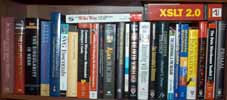Books on Semantics and Linguistics
My background is mostly in computer integration. I help organization
design cost-effective ways for computers to exchange semantically precise
information. One of the most important items to remember about the
exchange of information between computers is that today we are burdened with
metaphors on human-human communication. Which is really not just semantics
but also linguistics. So if you are interested in integration, my advise
is to read up on both semantics and linguistics.
Semantics in Business Systems
Dave McComb
If you are looking for a very strong book on the business aspects of the
semantic web, this book is an excellent choice. This is not a programmer's
book but rather a book targeted at managers, project managers and business
analysts. Dave is one of the key figures behind the Semantic Technology
conference and is well connected to many of the key players in the semantic web
movement including Jim Hendler that wrote the foreword to the book. This
book also has an excellent explanations of how the field of semantics fits in
with other areas such as integration, web services, analytics and business
rules.
A Semantic Web Primer
Grigoris Antonius and Fran van Harmelen
This is one of the few books available on the semantic web that is appropriate
for use in a full course. It begins with a background on XML, RDF and OWL
and then has sections on login and inference, rules, applications, ontology
engineer and a discussion on future directions of the semantic web. Each
chapter includes a good list of suggested reading, exercises and projects.
The book is very well written overall despite the authors background (professors
in Greece and the Netherlands).
Spinning the Semantic Web
Edited by Dieter Fensel, James Hendler, Henry Lieberman and Wolfgang Wahlster
This is a collection of papers on semantic technologies written before the owl
standard was published. It has some well-written articles by the "big
guns" that are driving the semantic web, but is not appropriate as a tutorial.
The material is really a collection of papers that describe academic research
projects or impact analysis of what could be done if semantic web standards were
in place. The book does give an interesting perspective of how semantic
web technologies are built on XML, XML Schema, RDF and RDFS.
The Meaning of Meaning: A Study of the Influence of Language upon Thought and of the Science of Symbolism
by C. K. Ogden and I. A. Richards (First published in 1923)
I first encountered references to this book when reading about the semantic web.
The key innovation was the "semiotic triangle" where we are encouraged to think
of things, thoughts and symbols in separate and distinct domains. I now use the
"semantic triangle" (a more approachable name) in many of my semantic web
training classes. The key concepts to get across to students is that when computers need to
communicate, there are many limitations when using symbols alone, which can have
many different meaning within different contexts. For example the word "run"
has over 50 different meanings according to WordNet. A more robust way to
exchange information between computers is to associate data elements with
concepts. This books was one of the first books to build these models of
communication. I wrote an article on the semiotic triangle on
Wikipedia.
Metaphors We Live By
George Lakoff and Mark Johnson
This book helps us understand why metaphor is much more than just a simple
literary device. Lakoff is influential linguist from UC Berkeley. He
has been one of the most well-regarded authors in the field of linguistics.
For example, here is a simple question posed on page 246. Do we
systematically use inference patterns from one conceptual domain to reason about
another conceptual domain? As this book points out, the answer is yes.
And anyone that is trying to build semantically reliable communications between
different computer systems based on semantic technologies needs to understand
this. For example take the phase: "Time is Money". Sounds like a
simple metaphor. This book points out that cultures that use this metaphor
may view the world differently then cultures that do not. This book,
originally published in 1980, has been reprinted many times and is used in many
different fields.
Women, Fire, and Dangerous Things: What Categories Reveal about the Mind
George Lakoff
This is an excellent book by a linguist from CA Berkeley that helps us
understand the concept of categorization. Categorization is a principal
concept that is used whenever we create a metadata registry. Any time you
use the ISO-11179 representation terms Indicator or Code you are really
categorizing data. This book takes you through a through analysis of
categorization from a linguistic perspective. This is key because is it
humans that usually choose how to categorize data. Our job as a metadata
architect is to understand that these processes are often arbitrary, driven by
cultural lenses and not always rational. Think of PersonRaceCode or
ProductColorCode. The book is well written and fun to read. By the
way, the title refers to the Aboriginal word balan, which also tells you
something about Aboriginal culture.
| 






